Tree peony, care and cultivation, propagation methods, pruning, why it doesn’t bloom

Growing and caring for tree peony is a real pleasure for amateur gardeners.
Not particularly demanding in terms of maintenance conditions, the bush, with amazingly beautiful foliage, decorates the garden every spring with its large, brightly colored flowers.
Content:
- General characteristics of tree peony
- Types and varieties
- How to grow tree peony from seeds
- Other propagation methods
- Planting a tree peony
- Growing tree peony and caring for the plant
- Why doesn't the bush bloom?
- How to rejuvenate a tree peony
- Autumn pruning of tree peony
general characteristics
The tree peony is the closest relative of the herbaceous peony, possessing powerful lignified stems. It can be considered more of a shrub than a regular flower. Some individuals are capable of growing up to 1.5-2 meters. Blooming buds reach a diameter of 14 to 23 cm.
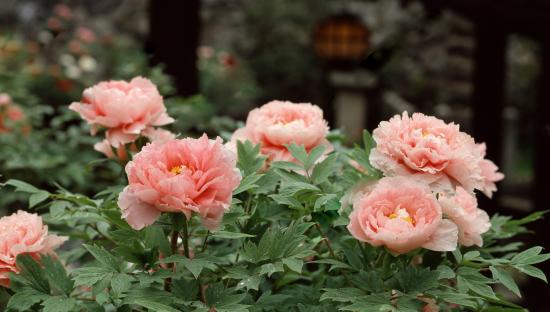
In general, the appearance of a tree peony largely depends on the care received and the characteristics of cultivation. Usually this plant looks like a spherical shrub covered with bright lush multi-petaled inflorescences.
An adult viable plant can bloom with 50-60 flowers at the same time. If you follow the rules of care, the plant will delight you with its flowers for a long time, for 3-4 weeks. The time when flowering begins varies depending on weather conditions.Most often, the flowering period coincides with the beginning of summer.
Types and varieties
Tree peony flowers can have different colors. It depends on the variety of plant grown. White and pink are more common, but there are lilac, scarlet, yellow, blue, and also light green (Green Jade variety).

There are varieties with gradient colored buds. The texture of the petals also depends on the plant variety. They can be terry, velvet, smooth.
The most popular varieties among domestic gardeners are:
- Sapphire;
- Coral Altar;
- Green Jade.
How to grow tree peony from seeds
Growing botanical species from seeds requires some patience. Unfortunately, the effectiveness of this method for tree peony does not exceed 10%. However, if a gardener has such a goal, it is worth a try.
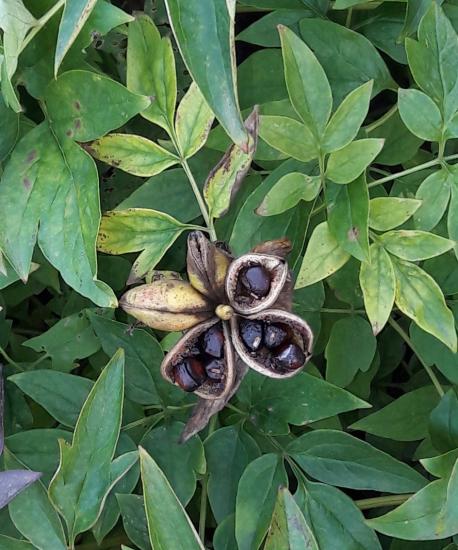
The easiest way is to plant the collected ripe seeds directly into the ground. You will have to wait about two years for the result. During dry periods, the crop bed is watered.
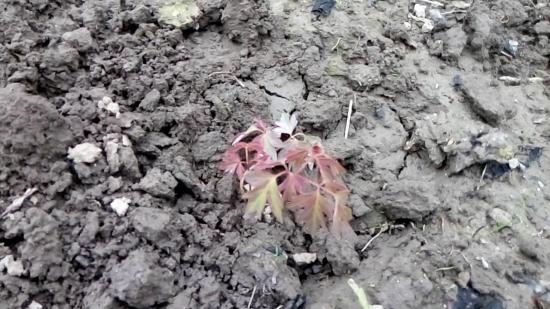
If everything goes well, shoots are expected to form in the second year. Individuals grown from seeds will begin to bloom after four years.
Other methods of reproduction
More rational methods of propagation of this botanical species include those indicated in the table.
| Dividing the bush | The procedure is carried out in late summer - early autumn. 5-6 year old individuals are suitable for division. To plant a new bush, a part of the rhizome with 10-20 cm young roots and 2-3 buds is separated. The separation areas are treated with fungicide or charcoal. |
| Reproduction by layering | The procedure begins before flowering begins. The method is not always possible to implement, since the prevailing direction of plant growth is upward.If any shoot can be painlessly pressed to the ground, it must be securely slightly trimmed on the side facing the ground, secured at the bottom and sprinkled with earth. The place of intended rooting is watered equally with the parent plant. After 2-3 years, such layering forms a full-fledged root system. |
| Grafting onto the root of herbaceous peony | This technique is the most effective and therefore popular. Vaccinations are used to obtain industrial quantities of seedlings for further sale. This is done by professionals in specialized nurseries. If you wish, you can try to do the grafting yourself, but not every amateur gardener succeeds in this on the first try. |
| Cuttings | The procedure is carried out at the end of June. Semi-lignified shoots are taken as cuttings. The cuttings are stuck to a depth of 1.5 cm into a container filled equally with sand and peat. The plantings are covered with a glass cap or oilcloth. At the beginning of autumn, viable individuals are transplanted into separate pots and transferred to the greenhouse. In spring, young plants are transplanted into open ground. |
Planting a tree peony seedling
An adult tree peony has an impressive size, so for planting you need to choose a place at a decent distance from other shrubs and trees. Plenty of light and alkaline soil are two other factors that are needed for the development of a viable shrub.
It is important to take into account that the plant really does not like transplanting. If this happens, the bush can “come to its senses” for about 2-3 years, even if the manipulations are performed strictly according to the rules. Therefore, it is better to initially choose a site that will become the permanent residence of the flower.
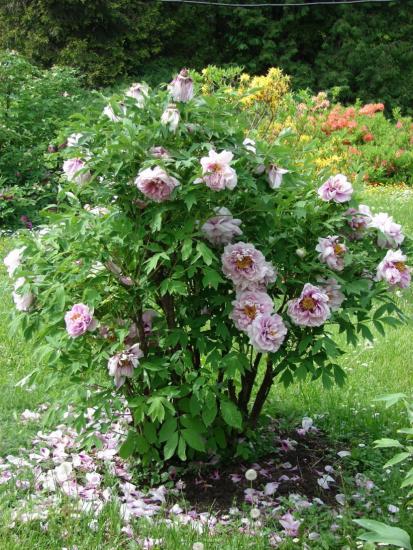
The optimal time for planting a seedling is late summer-early autumn.The best soil is loam. If the site is dominated by sandy soils, the planting site should be enriched with humus, peat, and turf in advance.
Acidic soil is pre-alkalinized with lime or ash. Broken bricks, pebbles, gravel, and river sand are used for drainage.
The immediate process of planting a seedling involves the following steps:
- A small mound of soil is constructed in the center of the planting hole.
- The prepared seedling is placed on the top of a makeshift mound and the roots are straightened around it.
- The plant is watered generously.
- They wait for some time for the water to be absorbed, then the hole is filled up. In this case, it is important that the root collar of the bush is at the level of the ground surface.
The flowering of tree peony begins five years after planting.
You can get flowers as quickly as possible by grafting; it is possible that the plant will delight you with flowers in the first year.
Shrubs with a “native” root system develop slowly during the first years of life. Sometimes it seems that the flower is not growing at all. This phenomenon is quite normal - during this period all efforts are spent on the formation and strengthening of the root system.
For more information on how to plant a tree peony, about caring for and growing the plant, see the video:
Tree peony: care and cultivation
Watering is an important factor influencing the condition of any botanical species. Tree peony also needs abundant, but not too frequent, irrigation. It is important that the water does not stagnate. That is why, before planting plants in clay soil, they take care of high-quality drainage.
On average, a tree peony bush needs 6-8 liters of water per watering. Irrigation is carried out 2-3 times a month, taking into account the presence or absence of natural precipitation.
At the end of summer, artificial watering is completely stopped.
Used as fertilizer for tree peony nitrogenous and potassium-phosphorus fertilizers. However, it is important to know when to stop and not to “overfeed” the bush. It is better to do without fertilizing at all than to cause irreparable harm to the tree peony.

Tree peony easily tolerates cold winters in the middle zone. It is worth covering it only during particularly severe frosts. To protect the bush, you can use both special materials (spunbond, burlap, lutrasil) and cut spruce paws.
If the autumn turns out to be damp and warm, the tree peony continues to develop and does not have time to “fall asleep” before the onset of frost. To avoid the death of the bush, experienced gardeners recommend preparing the plant in advance for the onset of serious cold weather.
Recommended:
- completely stop watering at the end of August;
- if autumn is too rainy, the bush should be covered under a temporary canopy. Excess moisture during this period is undesirable;
- carry out sanitary and anti-aging pruning.
Why doesn't the bush bloom?
Sometimes amateur gardeners are concerned about the lack of flowering of tree peony. The reason for this may be either improper care or some other natural features.
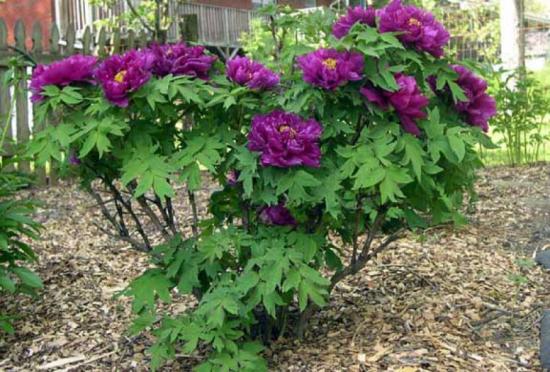
Most often, the lack of flowering is associated with the following factors:
- plant age. It may either be too young or already too old;
- excessive deepening of shrubs during planting;
- abuse of nitrogen-containing fertilizers;
- compliance of the characteristics of the plant variety with the climatic features of the area;
- insufficient amount of sunlight;
- too close proximity to other plants;
- unsuccessful transplant;
- insufficient or excessive watering;
- incorrect pruning.
It is important to correctly determine the reason why the shrub does not bloom and quickly correct improper care.
How to rejuvenate a plant
Rejuvenation of the tree peony is carried out by radical pruning. The procedure is carried out after 10 years of the plant’s life..
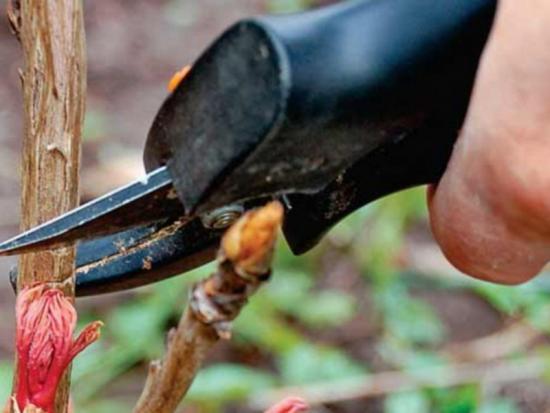
The shoots should be cut at the root. The procedure promotes growth activation. If everything is done correctly, the flower will receive a powerful impetus to further development.
Autumn pruning of tree peony
The usual time for this procedure is spring. It is carried out in a gentle manner. Frostbitten shoots should not be removed. It is likely that they will move away and delight their owners with lush flowers.
If necessary, pruning is done in the fall. Autumn procedures increase the frost resistance of the shrub. You should wait until October and remove non-viable shoots. Old branches are shortened by 5-10 cm. Also in the fall, ripe seed heads are removed.
We will learn about the correct pruning of a peony by watching the video:
Caring for a tree peony does not require complex manipulations. The main task is to choose a good site for planting and not to overdo it with fertilizers and watering.


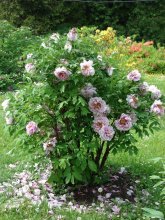


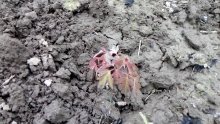

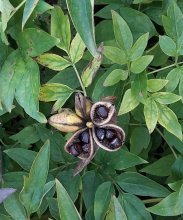

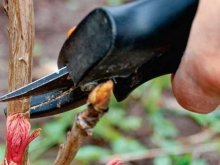



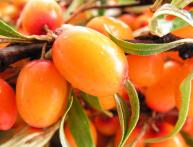
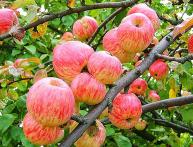
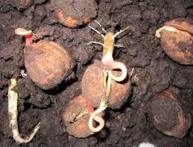

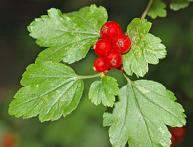
Comments
We have ordinary peonies growing in our garden, not tree-like ones. They do not require any care other than watering and weeding around, and they always bloom very beautifully in late May and early June. I have never seen tree peonies in our city.